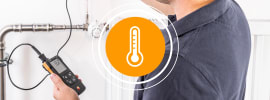- Home
- Applications
- Revealing the invisible
Revealing the invisible
Reliable detection of moisture and water damage in buildings.
With thermal imagers from Testo.

The existence of moisture and water penetration in buildings has far-reaching effects on their value, structure and the health of their occupants. Particularly in times of more extreme weather events such as heavy rain, storms or monsoon rains in Asia, for example, this problem is exacerbated. In this context, infrared thermography is proving to be a valuable tool for building inspectors and renovation specialists to help them identify and resolve damp problems from a variety of sources (see right).
Not every case of moisture in walls is due to a burst pipe. Damp walls and ceilings can also be caused by water penetration (e.g. leaking roofs) or rising damp. Damp damage can also be caused by blocked drains or inadequate drainage.
Using thermal imagers from Testo allows you to reliably identify the cause of rising damp or rainwater ingress before these problems result in any serious damage.

Ground moisture (groundwater)
Ground moisture (pressure)
Seepage water
Driving rain
Heavy rain
Damage to the roof
Defective guttering
Examples of moisture and water damage

Water intrusion

Roof leakage

Rising damp
What should I look out for when choosing the right thermal imager?
High thermal sensitivity (NETD) for detecting the slightest differences
Precision-adjustable temperature interval (span) for higher-contrast imaging
High infrared resolution for optimal image quality
Our recommendation: testo 883-1
Very good NETD of
Temperature interval adjustable up to 1 K
IR resolution of 320 x 240 pixels
(with SuperResolution 640 x 480 pixels)Wide-angle lens for large field of view in confined spaces
Manual focus for sharp thermal images

How to successfully thermograph damage caused by penetrating water and rising damp
For flat roofs: Roof surface must be unobstructed (no green roof or gravel stones), sunlight during the day, imaging is carried out in the evening, damp area stores solar heat longer and becomes visible as a warmer area in the thermal image
Penetrating or rising damp results in evaporative cooling. This is best visualized when the temperature interval on the scale (span) is as narrow as possible.
Do not take thermographic images from outside in high humidity, moisture (rain, snow) or strong winds
Use a material moisture meter for support
After eliminating the cause, carry out comparative measurements of the drying process
Find the right thermal imager for every requirement
At Testo, you’ll also find the ideal humidity measuring instrument for your multi-point measurements














































